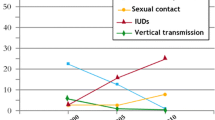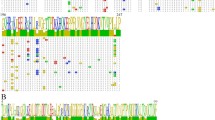Abstract
The simultaneous presence of multiple HIV-1 subtypes has become common in communities with the growth of the pandemic. As a consequence, the potentiality for an increased frequency of HIV-1 mixed infections caused by viruses of distinct subtypes could be expected. Thus, there is a need to estimate the prevalence and geographic distribution of infections caused by viruses of a singular subtype as well as coinfections caused by two or more HIV-1 strains of distinct subtypes. To address this need, we have developed a genetic method based on restriction fragment length polymorphism (RFLP) to screen for these two types of infections within infected populations. In this assay, restriction enzymes may be used to predict the phylogroup of HIV-1 infected samples. A 297 bp pol fragment spanning the entire viral protease gene and a 311 bp fragment of the p24 gag region are used for this analysis. The viral regions are amplified by nested PCR using DNA templates from uncultured peripheral blood mononuclear cells (PBMC) or virus culture. Classification of HIV-1 strains to well defined subtypes B, D, F, and A/C is done by sequential endonuclease restriction analysis of a PCR amplified-protease gene followed by analysis of the p24 gag region. The electrophoretic migration patterns visualized by ethidium bromide staining or by radiolabeled probes are then determined on a 10% polyacrylamide gel. In infections caused by viruses of a singular subtype, a single restriction pattern is detected, whereas in multiple infections caused by two or more viral strains of different subtypes, the combination of different digestion patterns are observed in infected individuals. Using this methodology we have screened for genetic variations in HIV-1 proviral DNA from thirty-three Brazilian samples. Our RFLP procedure classified thirty-two samples as single infections caused by viruses of subtypes B (31) and F (1), and one sample as dual infection caused by distinct viral strains. Subsequent sequence and phylogenetic analysis of the viral protease gene in lymphocytes of all these patients confirmed our RFLP findings in single infections, and demonstrated the existence of two distinct HIV-1 strains of subtypes F and D in a patient which lymphocytes showed the simultaneous presence of two different digestion patterns. As up to now, single infections caused by subtype D variants were not identified in Brazil, our data provide the first evidence of subtype D HIV-1 in this country. Because sequencing of HIV proviral DNA is not particularly practical for large-scale molecular epidemiological studies, the protease/gag-based RFLP screening method will be useful to predict the phylogroup of HIV-1, and to identify multiple infections caused by HIV-1 strains of distinct subtypes. We believe that this information is crucial for both evaluation of the HIV-1/AIDS pandemic and intervention strategies.
Similar content being viewed by others
References
AlizonM., Wain-HobsonS., MontagnierL., and SonigoP., Cell46, 63–74, 1986.
GoodenowM., HuetT., SaurinW., KwokS., SninskyJ., and Wain-HobsonS., J Acquired Immune Defic Syndr2, 344–352, 1989.
SimmondsP., BalfeP., LudlamC.A., BishopJ.O., and Leigh BrownA.J., J Virol64, 5840–5850, 1990.
MeyersG., RabsonA.B., BerzofskyJ.A., SmithT.F., and Wong-StaalF. (ed).Human Retroviruses and AIDS. Los Alamos National Laboratory, Los Alamos, New Mexico, 1994.
CohenJ., Science264, 1839, 1994.
KliksS.C., ShiodaT., HaigwoodN.L., and LevyJ.A., Proc Natl Acad Sci USA90, 11518–11522, 1993.
MooreJ. and AndersonR., Nature372, 313–314, 1994.
ReyF., SalaunD., LesbordesJ.L., GadelleS., Ollivier-HenryF., Barre-SinoussiF., ChermannJ.C., and GeorgesA.J., Lancetii, 1391–1392, 1986.
EvansL.A., OdehouriK., Thomson-HonnebierG., BarbozaA., MoreauJ., SetoD., LeggH., Cheng-MayerC., and LevyJ.A., Lancetii, 1389–1391, 1988.
RayfieldM., DeCockK., HeywardW., GoldsteinL., KrebsJ., KwockS., LeeS., McCormickJ., MoreauJ.M., OdehouriK., SchochetmanG., SinskiJ., and OuC.Y., J Infect Dis158, 1170–1176, 1988.
GeorgeJ.R., OuC.U., ParekhB., BrattegaardK., BrownV., BoatengE., and deCockK.M., Lancet340, 337–339, 1992.
PeetersM., Gershy-DametG.M., FransenK., KoffiK., CoulibalyM., DelaporteE., PiotP., and van derGroenG., Lancet340, 339–340, 1992.
PieniazekD., PeraltaJ.M., FerreiraJ.A., KrebsJ.W., OwenS.M., SionF.S., FilhoC.F.R., SerenoA.B., deSaC.A., WenigerB.G., HeywardW.L., OuC.Y., PieniazekN.J., SchochetmanG., and RayfieldM., AIDS5, 1293–1299, 1991.
GrezM., DietrichU., BalfeP., vonBriesenH., ManiarJ.K., MahambreG., DelwatrE.L., MullinsJ.I., and Rubsamen-WaigmennH., J Virol68, 2161–2168, 1994.
SalaM., ZambrunoG., VartanianJ.-P., MarconiA., BertazzoniU., and Wain-HobsonS., J Virol68, 5280–5283, 1994.
KellamP. and LarderB.A., J Virol69, 669–674, 1995.
PossM., MartinH.L., KreissJ.K., GranvilleL., ChohanB., NyangeP., MandaliyaK., and OverbaughJ., J Virol69, 8118–8122, 1995.
ZhuT., WangN., CarrA., WolinskyS., and HoD., J Virol69, 1324–1327, 1995.
DiazR.S., SabinoE.C., MayerA., MosleyJ.W., BushM.P., and the Transfusion Safety Study Group, J Virol69, 3273–3281, 1995.
LiW.W., TanimuraM., and SharpP.M., Mol Biol Evol5, 311–330, 1988.
SabinoE.C., ShpaerE.G., MorgadoM.G., KorberB.T.M., DiazR.S., BongertzV., CavalcanteS., Galvao-CastroB., MullinsJ.I., and MayerA., J Virol68, 6340–6346, 1994.
RobertsonD.L., ScharpP.M., McCutchanF.E., and HahnB.H., Nature374, 124–126, 1995.
RobertsonD.L., HahnB.H., and SharpP.M., J Mol Evol40, 249–259, 1995.
LeitnerT., EscanillaD., MarquinaS., WahlbergJ., BrostromC., HanssonH.B., UhlenM., and AlbertJ., Virology209, 136–146, 1995.
GaoF., YueL., RobertsonD.L., HillS.C., HuiH., BiggarR.J., NeequayeA.E., WhelanT.M., HoD.D., ShawG.M., SharpP.M., and HahnB.H., J Virol68, 7433–7447, 1994.
GaoF., YueL., WhiteA.T., PappasP.G., BarchueJ., HansonA.P., GreeneB.M., SharoP.M., ShawG.M., and HahnB.H., Nature358, 495–499, 1992.
ArtensteinA.W., VanCottT.C., MascolaJ.R., CarrJ.C., HegerichP.A., GayweeJ., Sanders-BuellE., RobbM.L., DayhoffD.E., ThitivichianlertS., NitayaphanS., McNeilJ.G., BirxD.L., MichaelR.A., BurkeD.S., and McCutchanF.E., J Infect Dis171, 805–810, 1995.
SchechterM., ZajdenvergR., MachadoL.L., PintoM.E., LimaL.A.A.L., and PerezM.A., J Acquired Immune Defic Syndr7, 163–168, 1994.
PottsE.K., KalishM.L., LottT., OrloffG., LuoC.C., BernardM.A., AlvesC.B., BadaroR., SuleimanJ., FerreiraO., SchochetmanG., JohnsonJr.W.D., OuC.Y., HoJ.L., and the Brazilian Collaborative AIDS Research Group, AIDS7, 1191–1197, 1993.
FeorinoP.M., KalyanaramanV.S., HaverkosH.W., CabradillaC.D., WarfieldD.T., JaffeH.W., and HarrisonA.K., Science225, 68–72, 1984.
OuC.Y., MooreJ.L., and SchochetmanG., Biotechniques10, 442–444, 1991.
CanoR.J., PoinarH.N., PieniazekN.J., AcraA., and PoinarJr.G.O., Nature363, 536–538, 1993.
OuC.Y., CiesielskiC.A., MyersG., BandeaC.I., LuoC.C., KorberB., MullinsJ., SchochetmanG., BerkelmanR.L., EconomouA.N., WitteJ., FurmanL.J., SattenG.A., MacInnesK.A., CurranJ.W., JaffeH.W., Laboratory Investigation Group, and Epidemiologic Investigation Group, Science256, 1165–1171, 1992.
HigginsD.G. and SharpP.M., Comput Appl Biosci5, 151–153, 1989.
GDE version 2.2 program. Developed at the University of Illinois for the Ribosomal Data project. Available from the University of Illinois.
LarsenN., OlsenG.J., MaidakB.N., McCaugheyM.J., OverbeekR., MackeT.J., MarshT.L., and WoeseC.R., Nucleic Acids Res21, 3021–3023, 1993.
Ramos A., Tanuri A., Janini L.M., Pinto M., Schechter M., Peralta M., Bandea C., Schochetman G., Rayfield M., and Pieniazek D., HIV-1 infections in Brazil: single, duals and recombinants. Abstract. 96th ASM General Meeting, New Orleans, LA, May 19–23, 1996, #3456.
LouwagieJ., DelwartE.L., MullinsJ.I., McCutchanF.E., EddyG., and BurkeD.S., AIDS Res Hum Retroviruses10, 561–567, 1994.
MorgadoM.G., SabinoE.S., ShpaerE.G., BongertzV., BrigidoL., GuimaraesM.D.C., CastilhoE.A., Galvao-CastroB., MullinsJ.I., HendryR.M., and MayerA., AIDS Res Hum Retroviruses10, 569–576, 1994.
WHO network for HIV isolation and characterization, AIDS Res Hum Retroviruses10, 1327–1343, 1994.
Ellenberger D.L., Luo C.-C., Pieniazek D., Maurice C., Nkengasong J., Janini L.M., Ramos A., Coulibaly I.M., Wiktor S.Z., Greenberg A.E., Schochetman G., and Rayfield M., Analysis of genetic diversity of HIV-1 in Cote d'Ivoire using restriction fragment length polymorphism (RFLP) analyses. Abstract. 11th International Conference on AIDS, Vancouver, Canada, July 7–11, 1996, #2065.
PieniazekD., JaniniL.M., RamosA., TanuriA., SchechterM., PeraltaJ.M., VicenteA.C.P., PieniazekN.J., SchochetmanG., and RayfieldM.A., Emerging Infectious Diseases1, 86–88, 1995.
Author information
Authors and Affiliations
Additional information
Use of trade names is for identification only and does not constitute endorsement by the Public Health Service or the US Department of Health and Human Services.
Rights and permissions
About this article
Cite this article
Janini, L.M., Pieniazek, D., Peralta, J.M. et al. Identification of single and dual infections with distinct subtypes of human immunodeficiency virus type 1 by using restriction fragment length polymorphism analysis. Virus Genes 13, 69–81 (1996). https://doi.org/10.1007/BF00576981
Received:
Accepted:
Issue Date:
DOI: https://doi.org/10.1007/BF00576981




